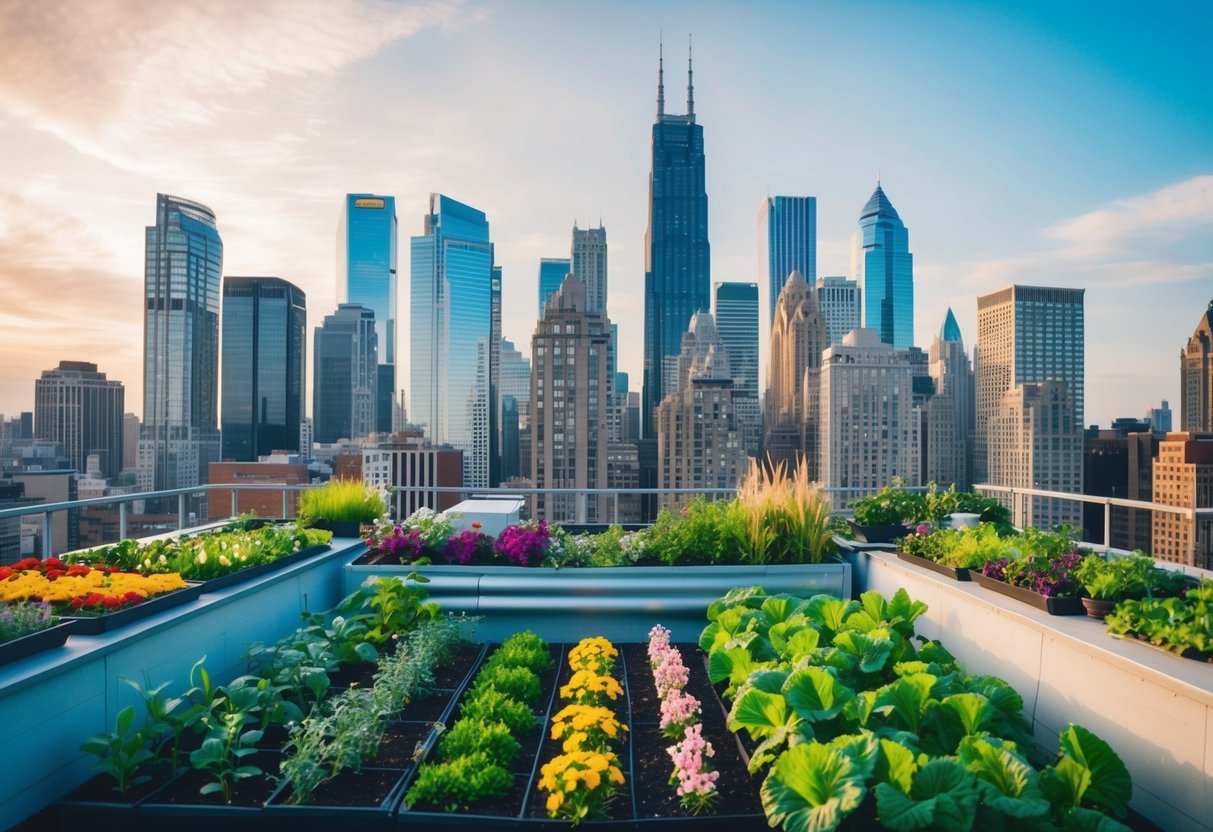
Practical Maintenance Tips
Regular maintenance is key to vibrant green spaces and a flourishing urban rooftop garden. Focusing on consistent care practices and adjusting methods seasonally ensures the garden remains healthy throughout the year.
Regular Upkeep and Pest Management
Maintaining an urban rooftop garden involves consistent attention to plant needs. Watering should be done based on the plant’s specific requirements and the climate. Checking soil moisture regularly can prevent both overwatering and underwatering. It’s also vital to remove weeds consistently, as they compete for nutrients and disrupt the garden’s ecosystem.
For pest management, it is advisable to use non-toxic methods, such as introducing beneficial insects like ladybugs which help control pest populations naturally. Regular inspection of plants will aid in early detection of issues, enabling timely intervention. Pruning dead or diseased parts ensures better growth and reduces pest habitats.
Seasonal Care for a Flourishing Garden
Seasonal changes demand adjustments in gardening practices to ensure plants thrive year-round. During the growing season, fertilization provides much-needed nutrients, supporting growth and vigor. Use organic compost to enrich the soil without the risk of chemical buildup.
Transitioning into colder months, apply mulching to regulate root temperatures and retain moisture. This protects plants from harsh winter conditions and reduces the need for frequent watering. Selecting hardy plant varieties that can withstand seasonal shifts also contributes to a more resilient garden. Proper seasonal preparation ensures continuous vitality, allowing the garden to flourish in urban environments.
The Environmental Impact of Rooftop Gardens
Rooftop gardens provide numerous environmental benefits, such as improving air quality and reducing urban heat. They also offer an opportunity to decrease individual carbon footprints through sustainable gardening practices.
Mitigating Urban Environmental Issues
Urban areas often face challenges like air pollution and elevated temperatures. Rooftop gardens address these issues by introducing greenery that helps filter pollutants and provide cleaner air. Plants absorb carbon dioxide and release oxygen, contributing to air purification.
The addition of greenery also combats the urban heat island effect. Cities tend to be warmer than surrounding areas due to concrete and asphalt absorbing heat. Rooftop gardens counteract this by providing natural shade and cooling through the process of evapotranspiration.
Moreover, green roofs offer natural insulation, reducing the need for artificial heating and cooling. Their vegetation layer acts as an insulating material, keeping buildings cooler in summer and warmer in winter. This reduces energy consumption and contributes to environmental conservation.
Reducing Carbon Footprint through Gardening
Gardening on rooftops can significantly reduce individual carbon footprints. Growing food in urban settings minimizes the need for transportation, reducing greenhouse gas emissions. This local production of fruits and vegetables decreases dependence on store-bought produce that often travels long distances.
Urban rooftop gardens encourage sustainable practices such as composting and rainwater harvesting. These methods cut down waste and conserve resources, making gardens more eco-friendly. Composting organic waste helps reduce methane emissions, while rainwater harvesting alleviates the pressure on traditional water supplies.
In addition, plants in rooftop gardens sequester carbon dioxide, mitigating climate change effects. By trapping carbon in their biomass, they contribute positively to the environment. This sustainable gardening approach emphasizes the role individuals can play in reducing their environmental impact.
Harvesting and Enjoying Your Produce
Growing a rooftop garden offers city dwellers the opportunity to cultivate their own fresh produce. Harvesting at the right time and understanding how to incorporate these fresh foods can transform urban spaces into vibrant green havens.
Best Practices for Harvesting Rooftop Crops
Timing is crucial when harvesting rooftop crops. Each type of produce has an ideal picking time that ensures peak flavor and nutrition. For example, tomatoes should be firm with a rich color, while leafy greens like lettuce are best cut in the morning when the leaves are crisp. Sun exposure during the day can make crops wilt, so early harvesting is advisable.
Use clean, sharp shears to avoid damaging plants. When it comes to root vegetables such as carrots, gently loosen the soil before pulling to prevent breaking. Regularly harvesting your produce also encourages more growth, keeping your garden lush and productive. Proper harvesting techniques ensure a steady supply of organic produce that enhances city life with healthy, home-grown bounty.
Using Your Rooftop Harvest for Healthy Living
Turning your rooftop produce into nutritious meals enriches a healthy lifestyle. Fresh fruits and vegetables from your garden are free of pesticides, making them a safe choice for wholesome dishes. Simple salads with hand-picked herbs can be a staple, while smoothies crafted from rooftop fruits provide a refreshing boost.
Cooking with organic produce not only maximizes flavor but also adds nutritional benefits. Incorporate your harvest into everyday meals by trying new recipes that highlight seasonal ingredients. Engage friends and family in farm-to-table dining experiences right in the heart of the city, creating a communal connection with the benefits of urban gardening.